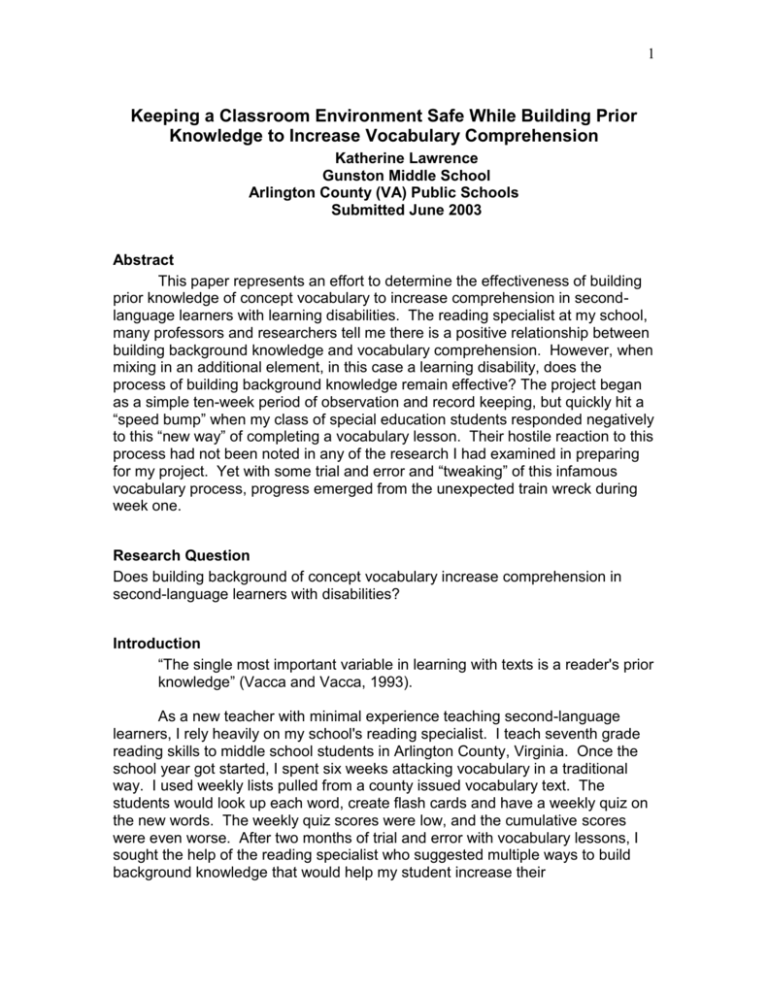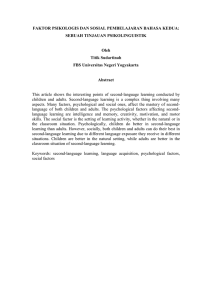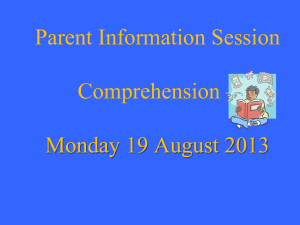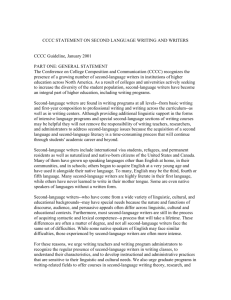Does builidng background of concept vocabulary increase
advertisement

1 Keeping a Classroom Environment Safe While Building Prior Knowledge to Increase Vocabulary Comprehension Katherine Lawrence Gunston Middle School Arlington County (VA) Public Schools Submitted June 2003 Abstract This paper represents an effort to determine the effectiveness of building prior knowledge of concept vocabulary to increase comprehension in secondlanguage learners with learning disabilities. The reading specialist at my school, many professors and researchers tell me there is a positive relationship between building background knowledge and vocabulary comprehension. However, when mixing in an additional element, in this case a learning disability, does the process of building background knowledge remain effective? The project began as a simple ten-week period of observation and record keeping, but quickly hit a “speed bump” when my class of special education students responded negatively to this “new way” of completing a vocabulary lesson. Their hostile reaction to this process had not been noted in any of the research I had examined in preparing for my project. Yet with some trial and error and “tweaking” of this infamous vocabulary process, progress emerged from the unexpected train wreck during week one. Research Question Does building background of concept vocabulary increase comprehension in second-language learners with disabilities? Introduction “The single most important variable in learning with texts is a reader's prior knowledge” (Vacca and Vacca, 1993). As a new teacher with minimal experience teaching second-language learners, I rely heavily on my school's reading specialist. I teach seventh grade reading skills to middle school students in Arlington County, Virginia. Once the school year got started, I spent six weeks attacking vocabulary in a traditional way. I used weekly lists pulled from a county issued vocabulary text. The students would look up each word, create flash cards and have a weekly quiz on the new words. The weekly quiz scores were low, and the cumulative scores were even worse. After two months of trial and error with vocabulary lessons, I sought the help of the reading specialist who suggested multiple ways to build background knowledge that would help my student increase their 2 comprehension. I used KWL charts, Story Building, a Word Wall, Word Sorts and a few more activities. I was not very successful using these strategies with my students. They refused to try something new, complained, and performed poorly in class. Test scores dropped dramatically. Immediately, I assumed that it was my approach to the strategies, so I returned to the Reading Teacher to acquire more specifics as to how to build off of the their prior knowledge. I returned to the classroom feeling better prepared and began pulling vocabulary from context and exploring the words with the children. What I Tried The students, who were both second-language learners and native language learners, appeared to be struggling to make connections between what they already knew and what they were trying to learn. They were “fighting” even trying the new approach to learn vocabulary. They requested and eventually pleaded with me to let them go back to memorizing words each week for vocabulary quizzes rather than “talking about words", "what it reminds me of", "what I already know about this word”. Giving in to their desires, I resumed giving vocabulary quizzes based on memorization every other week. On the off week, with a new list of terms, I resumed with the new approach of learning vocabulary by helping each student make connections with their prior knowledge. The student’s vocabulary scores, while low, were relatively higher on the memorization quizzes. They were even higher than before I began to work every other week building prior knowledge. The informal assessments that I administered on the off weeks (non-memorized vocabulary weeks) from making connections remained low. Assessments didn’t require factual/accurate answers or definitions, but rather opinions and thought processes. The students loathed the weeks when they had to “talk” about words. Other teachers told me that they probably didn’t like having to try something new. I agreed with their opinions, but I still felt as if I might be the problem in this learning process. I decided to observe another classroom with second language learners. I went to a HILT class and watched as a teacher approached the activity in an almost mirror image of what I had been trying. It was as if we were reading from the same script. The major difference was that her students participated and found instant success. The in-class conversations were lengthy and all of the students wanted to participate. Mid-Project Adjustments I thought about what I had observed and realized that my students had never been that successful in any of our classroom discussions. In fact, 90% of my students are very uncomfortable with classroom discussions and in turn are very disruptive during discussions (attached is informal survey administered before winter break to assess students comfort level with classroom discussions). The majority of my students don’t even have the attention span of 3 five minutes for a topic that they are personally excited about, never mind a new vocabulary word. It was then that something so simple and extremely obvious became apparent. I teach Special Education and all of my students except for two have auditory processing deficiencies as well as Attention Deficit Disorder. I took those disabilities into consideration when adapting and modifying my language skills approach. What I had not considered was the students' comfort level or willingness to risk being wrong when approaching something new. My students told me they felt a type of academic failure everyday. Most of them have been dealing with this academic failure since 1st grade. To talk about something unknown like a word or to risk saying the “wrong” thing in a discussion result in academic shut down as well as behavior concerns. My classroom was no longer a “safe” learning environment to my students regardless of their native language. Research suggests that students learn best in a pleasant, friendly climate where they feel accepted by their teachers and their peers; feel a sense of safety and order because academic expectations, instructions, and the purpose for assignments are clear; feel confident in their ability to complete tasks successfully; and see the value in the learning activities (Marzano and Pickering et al., 1997; McCombs and Barton, 1998). Findings My failure wasn’t so much in my ability to lead the activity, but rather my inability to keep the environment safe and comfortable enough for them to risk failure in participating. Regardless of being a second-language learner or not, the students fear of failure was crippling their chance at success. Instead of “discussing words” the following week, I had another approach to implement – one with which they would be comfortable. I created a two-week pattern with the same list of words. The first week they were given a pretest of matching and defining. The next day they were divided into two groups and as a group defined each of the words, using a dictionary. The following day they corrected their pre-tests and created flashcards. Thursday, they studied their flashcards and took a post-quiz on Friday. Safe and predictable, the students were introduced to the words. The following week was devoted to slowly implementing a discussion about the words they had all been exposed to. We talked about the words. First in smaller groups and then as a class. Rather than using phrases such as "what does this word remind you of?" (not a “safe” phrase for these students due to concerns of what their friends may say), but rather with phrases such as “how did you memorize the word for the quiz?” The reply to my questions included “it sounded like…, it looked like the word…, it reminded me of the when I was…”. Extensions to My Approach Unaware, the students were building prior knowledge and talking about the words from their own perspective. Learning increases when students 4 collaborate in the learning process (Billmeyer and Barton, 1998). Quite simply, learning is a socially interactive process (Vygotsky, 1978). Some of my secondlanguage students didn’t understand another student’s thought process, and students were quick to explain their rationale for the word. The following day I had them in two groups writing sentences for their words. They shared them as a class with a sense of confidence. On Friday, unannounced, I had them take a quiz that asked them to write what each word meant to them. The quiz grades from the second week were much higher than the first Friday quiz. This pattern continued for several weeks. A level of comfort was slowly being reestablished during our vocabulary lessons. Studies have been conducted on the benefits of strategy use; these have shown that all students can benefit from using reading strategies, especially those who have had trouble in the past with reading (Palincsar and Brown, 1984; cf. Barton, 1997). When reading a novel, from which vocabulary words had been pulled, the students recognized the words and could tell me what the sentence meant. The second-language students were the best at this. As the weeks progressed the students have become more comfortable with the discussion part of the vocabulary lesson. They still like the concrete aspect of the pretest (they liked it because it was a time where it was okay to fail) and the two chances at the posttest. In warm-ups and random comprehension checks the second-language learners retained the words they learned this year with 80% accuracy. This progress has exceeded former teachers’ expectations as noted on previous IEPs. I did start to wonder if quiz scores were higher due to double exposure rather than building of prior knowledge. During two of the two-week sessions, I decided to introduce the students to a new list of words during the second week. They were not pleased with this change at all. It was as if I had reverted back to week one of the school year. Comfort levels were dropped, their desire to learn dropped, and the test scores were a flop! I decided that it was too late in the year for these students to have to take on a new learning pattern. Final Reflections To answer my question, does building background knowledge increase comprehension for second-language learners with learning disabilities, I am confident that it does. However, the accommodation that I made for my students (to keep their comfort level with new concepts high) also double exposed them to the material and concepts. Next time I would want to study the same concept of building prior knowledge for second-language learners with disabilities, but implement a new variable and a new format. First I would want to compare general education students and special education students more closely. Second, I would implement the lesson/process of building prior knowledge at the beginning of the school year. Therefore, I would be creating a safe learning environment with my students that included talking about words. 5 Research (Anthony and Raphael, 1989) and common sense tell us that the more a reader brings to the text in terms of knowledge and skills, the more he will learn and remember from what he reads (Billmeyer and Barton, 1998). References available upon request







